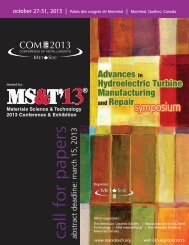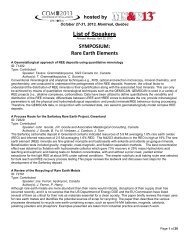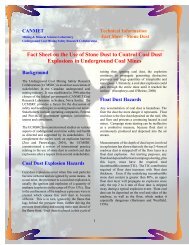List of Speakers SYMPOSIUM: Light Metals for Transportation
List of Speakers SYMPOSIUM: Light Metals for Transportation
List of Speakers SYMPOSIUM: Light Metals for Transportation
Create successful ePaper yourself
Turn your PDF publications into a flip-book with our unique Google optimized e-Paper software.
hosted byOctober 27-31, 2013, Montreal, Quebec<strong>List</strong> <strong>of</strong> <strong>Speakers</strong>Revised: Monday, April 22, 2013<strong>SYMPOSIUM</strong>:<strong>Light</strong> <strong>Metals</strong> <strong>for</strong> <strong>Transportation</strong>Further Improvement <strong>of</strong> Aluminium Reduction Cell Resistance Slope CalculationID: 72630Type: ContributedSpeaker: Marc Dupuis, GéniSim Inc, CanadaAuthor(s): M. DupuisAssuming that the cell is not excessively muck and hence that the evolution <strong>of</strong> the cell resistance is mostly dictated by theevolution <strong>of</strong> the concentration <strong>of</strong> the dissolved alumina in the bath, it is fair to say that culculating the slope <strong>of</strong> that cellresistance is an exact science.During the underfeeding regime from the lean side <strong>of</strong> the cell voltage vs aluminaconcentration curve, the gradual increase <strong>of</strong> the slope <strong>of</strong> the cell voltage is well known and the added bubble and MHDdriven cell voltage noise is very well known.Hence finding the optimal numerical algorythm to filted out that noise andcalculating the current noise free cell resistance slope is a straith <strong>for</strong>ward proposal. In the past the limited C.P.U. power <strong>of</strong>cell controler may have prevented the usage <strong>of</strong> such an algorythm, but this is no longer a limitation.Grain Refinement <strong>of</strong> Magnesium Alloys Using Ti-B, Ti-C and Al-B based additions: A ReviewID: 73104Type: ContributedSpeaker: Abdallah Elsayed, Ryerson University, CanadaAuthor(s): A. Elsayed, S. Lun Sin, C. RavindranGrain refinement is an effective method to improve the strength <strong>of</strong> an alloy. For Mg alloys containing Al, there is no widelyaccepted grain refiner. Current methods typically involve melt superheating or addition <strong>of</strong> carbon based materials such asgraphite, C2Cl6 and SiC. While effective, carbon inoculation methods are inconsistent and the mechanisms are unclear.Another class <strong>of</strong> grain refiners based on Ti-C, Ti-B and Al-B was recently introduced. This paper discusses thepreparation <strong>of</strong> these new refiners as well as their grain refining efficiency and resulting mechanical properties. In addition,focused areas <strong>for</strong> further research are highlighted.Grain Structure Evolution in Aluminium to Steel Ultrasonic Spot WeldingID: 71361Type: ContributedSpeaker: Farid Haddadi, Postech University, Korea SouthAuthor(s): F. Haddadi, P. PrangnellTraditional methods, such as resistance spot welding (RSW), are difficult to apply to aluminum to steel dissimilar weldingin multi-material automotive body structures because <strong>of</strong> the rapid growth intermetallic layer in liquid state. In comparison,ultrasonic welding (USW) uses only ~5% <strong>of</strong> the energy <strong>of</strong> RSW. Here, a detailed investigation has been per<strong>for</strong>med totrack the grain structure evolution in weld interface <strong>of</strong> the thermomechanical affected zones (TMAZs) using high resolutionSEM fitted with HLK EBSD system. In aluminium to un-coated steel welds severe de<strong>for</strong>mation was found to occur early onin the process, close to the join line, leading to the development <strong>of</strong> a fine grain structure by dynamic recrystallization.However, the evolution <strong>of</strong> the grain structures was seen to be delayed with zinc coated steel due to the lowertemperatures and de<strong>for</strong>mation that resulted from liquation <strong>of</strong> the zinc coat at the weld interface.In-Situ Scanning Electron Microscopy (SEM) Observations <strong>of</strong> the De<strong>for</strong>mation Behavior <strong>of</strong> Friction Stir WeldedAl2139-T8ID: 71549Type: ContributedSpeaker: Carl Boehlert, Michigan State University, USAAuthor(s): C. Boehlert, T. Sano, C. ChenPage 7 <strong>of</strong> 17


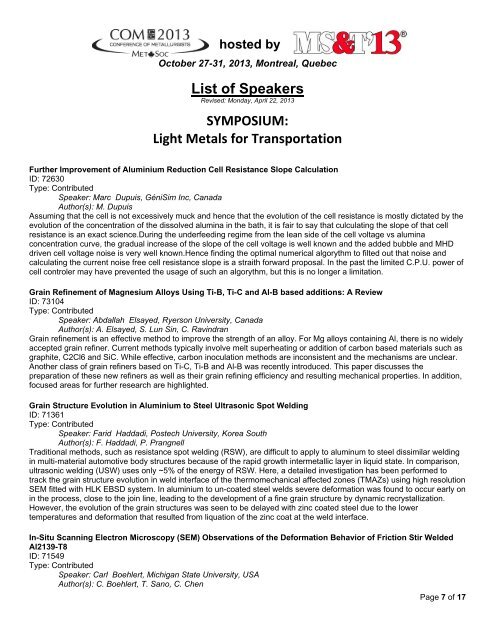

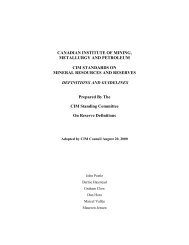
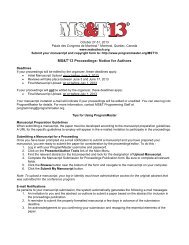


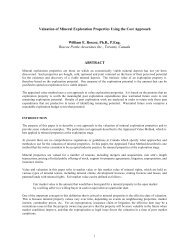
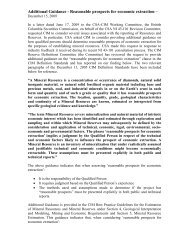
![Richard Wright - NORWEST Corporation [PDF]](https://img.yumpu.com/34320526/1/190x245/richard-wright-norwest-corporation-pdf.jpg?quality=85)
